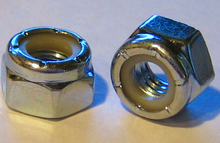


Alocknut, also known as a lock nut, locking nut, self-locking nut, prevailing torque nut,[1] stiff nut[1]orelastic stop nut,[2] is a nut that resists loosening under vibrations and torque. Prevailing torque nuts have some portion of the nut that deforms elastically to provide a locking action.[2] Free-spinning locknuts exist which carry the advantage of not requiring extra torque until seated.[3]
There are various kinds of specialised lock nuts, including:
Prevailing torque[7] differentiates a locknut from a free spinning nut based on a value of how much torque is required during installation before clamp loading. For example, on a nylon-insert nut, it is the torque needed to overcome the resistance of the nylon dragging across the mating thread. This torque value is usually not very high relative to final installation torque. Tolerance ranges for torque are specified in some standards such as (ISO, DIN, IFI, ASME, SAE, AN-, MS-, NAS- NASM-).[8]
Locknuts are one way to prevent vibration from loosening a bolted joint. Other methods include safety wire, lock washers, and thread-locking fluid.